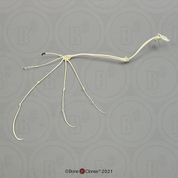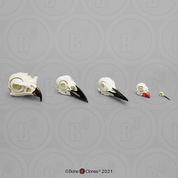-
Fields of Study
- K-12 Education
- Advanced Anatomy
- Forensics
- Physical Therapy
- Primate Locomotion
- Non-primate Locomotion
- Biological Anthropology
- Paleontology
- Bioarchaeology
- Marine-Aquarium
- Veterinary
-
Zoology
- All Zoological Items
- Endangered Species
- Skulls
- Skeletons
- Cranial Elements
- Postcranial Elements
- Eggs
- Limbs
- Teeth & Fangs
- Claws & Talons
- Brains & Endocasts
- Life Casts
- Pathology & Trauma
- Wildlife Forensics
- Sets
- Bird Sets
- Accessories
- Birds
- Mammals
- Reptiles & Amphibians
- Fish
- Sharks & Rays
- Turtles & Tortoises
- Anatomy for the Artist
- Decor
- Veterinary
- Elements
- Pathology & Trauma
-
Sets & Series
- Natural History Gift Ideas
- Decor
- Scale & Sculpture
- 3D Scanned & Printed
- Bone Boxes
- Locomotion Sets
- Forensic Sets
- Advanced Anatomy Sets
- Physical Therapy Series
- Fetal Sets
- Economy Series
- Zoology Sets
- Bird Sets
- Claw & Talon Sets
- Tooth & Fang Sets
- Primate Skull Sets
- Fossil Hominid Sets
- B.I.O.P.S.I. - Babiarz Institute
- Maxwell Collection
- Bergdorf Goodman Windows
- Accessories
- New Products
-
Our Company
- News & Specials
- Printable Handouts
- About Us
- Why Choose Bone Clones
- Bone Clones in the News
- Mission
- Contact Us
- Privacy and Security
- FAQs
- Testimonials
- Community Outreach
- Legal/Copyright
- Flyers
- Choosing Original Specimens
- Museum Exhibitions
- Natural History Gift Ideas
- About the Economy Series
- Acknowledgements
- Ordering & Delivery
- Warranty
- Refund/Return Policy
- Osteological Evaluation Reports
- About 3D Printing
- Sawyer & Maley Neanderthal Reconstruction
- Newsletter Archive
-
Human Anatomy
- All Human Anatomy
- Human Skulls
- Human Skeletons
- Head & Neck
- Postcranial Elements
- Advanced Anatomy
- Physical Therapy / Joints
- Human Brains & Endocast
- Human Life Casts
- Maxwell Museum
- Sets & Series
- Accessories
- Osteological Evaluation Reports
- Featured
- Adult Human Anatomy
- Adolescent Human Anatomy
- Child Human Anatomy
- Fetal Human Anatomy
-
Zoology
- All Zoological Items
- Endangered Species
- Skulls
- Skeletons
- Cranial Elements
- Postcranial Elements
- Eggs
- Limbs
- Teeth & Fangs
- Claws & Talons
- Brains & Endocasts
- Life Casts
- Pathology & Trauma
- Wildlife Forensics
- Sets
- Bird Sets
- Accessories
- Birds
- Mammals
- Reptiles & Amphibians
- Fish
- Sharks & Rays
- Turtles & Tortoises
- Fossil Hominids
- Paleontology
- Non-human Primates
- Forensics
All items sold on this website are replicas; no real/natural bone is available on this site. Bone Clones® are 1:1 scale unless stated otherwise. All Bone Clones® products are made in the USA.
- Migratory ,
- Bird ,
- veterinary
 ALSO SEE:
ALSO SEE:
Black-footed Albatross Wing, Articulated
SC-332-67-A $160.00
The wings of an albatross follow the classic vertebrate plan for the upper limb with some modifications for flight, such as modified joints for folding and locking of wings, fused wrist bones and a reduction of digits.
Avian skeletons include several unique features that enable flight. It is lightweight, often weighing less than the bird’s feathers. Certain bones, called pneumatic bones, are composed of air-sacs supported by cross-struts, which reduces the bone’s weight while maintaining its structural rigidity.
There are four basic bird wing shapes, each suited to specific environments and type of flight: Passive Soaring Wings for passively using thermal updrafts over land to soar, glide and circle; Active Soaring Wings for actively seeking air currents over oceans to travel long distances, Elliptical Wings for predator evasion, fast take offs, and short bursts of speed with high maneuverability, and High Speed Wings for prolonged high speed travel. There is one additional specialized shape, for hovering.
The Black-footed Albatross is an expert glider, capable of riding oceanic air currents for hours and over great distances using two main techniques. Its wing is a classic example of the Active (sometimes referred to as Dynamic) Soaring Wing shape: long and narrow (slender). Albatrosses repeatedly fly into wind to gain elevation, and descend downwind back to sea to gain speed. A second technique, known as Slope Soaring, uses the rising air on the windward side of large waves. A tendon in an albatross's upper wing acts as a "locking mechanism" which maintains horizontal wing orientation without much energy expenditure. Other birds with this wing shape include gulls and gannets.
If you have a preference of right or left side, let us know in the comment section during checkout. Otherwise, we will choose.
| Scientific Name | Catalogue # | Size | Price |
| Phoebastria nigripes | SC-332-67-A | 29 ½ " L extended 75cm L | $160.00 |
Related Products:
-
 Black-footed Albatross Skeleton, Articulated
Black-footed Albatross Skeleton, Articulated -
 Black-footed Albatross Skull
Black-footed Albatross Skull -
 Articulated Fruit Bat Wing
Articulated Fruit Bat Wing -
 Golden Eagle Wing, Articulated
Golden Eagle Wing, Articulated -
 North American Bird Egg Set
North American Bird Egg Set -
 Human Male Asian Arm, Articulated without Scapula
Human Male Asian Arm, Articulated without Scapula -
 Bottlenose Dolphin Pectoral Fin (Flipper)
Bottlenose Dolphin Pectoral Fin (Flipper) -
 Florida Manatee Forelimb Set
Florida Manatee Forelimb Set -
 California Condor Foot
California Condor Foot -
 Comparative Bird Skull Set of 5
Comparative Bird Skull Set of 5 -
 Raven Skeleton, Articulated Standing
Raven Skeleton, Articulated Standing -
 Kiwi Skeleton, Articulated with Egg
Kiwi Skeleton, Articulated with Egg -
 Elephant Bird Skull
Elephant Bird Skull -
 Great Horned Owl Set
Great Horned Owl Set -
 Dietary Comparison Economy Skull Set
Dietary Comparison Economy Skull Set
Newsletter Signup
9200 Eton Ave.
Chatsworth, CA 91311 USA
© 1992-2026 Bone Clones Holdings. All Rights Reserved.
Customer Service
© 2026 BONE CLONES HOLDINGS / Made by MEV















